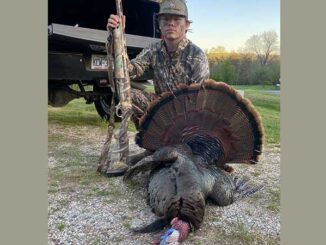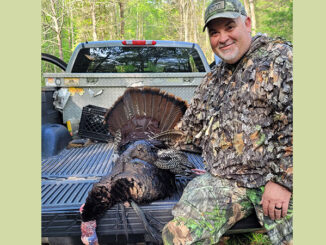
Shearon Harris Lake in Chatham County (only 20 miles south of Raleigh) is one of the premier largemouth bass destinations in the state.
In fact, biologists with the North Carlina Wildlife Resources Commission regularly note electro-shocking samples of 150 bass per acre, the highest in the state.
But the 4300-acre lake with a Progress Energy nuclear plant sitting on its north shore is one tough place to land bass during the hot days of summer.
Unless you find them schooling.
That’s what bass pro/guide Jeff Thomas of Broadway does during August.
“I like to get on the lake really early,” he said.
He looks for tell-tale schools of tiny threadfin shad moving across the lake surface at dawn, usually between two points in a feeder creek. When “schoolie” largemouths attack, they’re evident by slashing, exploding water.
Anyone with a topwater lure who is within casting range can hook up almost 90 percent of the time by throwing into these surface-schooling bass.
“They usually won’t be the large fish that Harris is known for, but you can have a lot of fun catching 2 to 4 1/2 pounders on top.” said Thomas (www.carolinaoutdoors.net, fishgetter@carolinaoutdoors.net).
During a recent August trip with an outdoor writer, the pair landed two dozen largemouths, mostly on Pop-Rs and Zara Spooks within trolling-motor distance of the Merry Oaks ramp.
“A lot of times the larger bass will be underneath the schoolers,” Thomas said.
He used a 5-inch Flutter Spoon and jigged it off the bottom underneath schooling bass, but had no luck.
“But I went with another writer last week (early August) and caught a 10-2 and an 8-8 with the spoon,” he said.
The N.C. Wildlife Resources Commission sets the lake’s creel and sizes limits (Harris also has white bass, catfish, large crappie and bluegills). The lake has a slot limit for largemouths (five total fish in a daily creel, 14-inch minimum size, none between 16 and 20 inches may be kept, but two less than 14 inches may be retained).
“The (bass) fishing should continue to get good through the fall when the fish start to come back shallow,” Thomas said. “But you’ll be able to catch schooling fish just about anytime.
“It’s just a matter of going riding until you see them blasting those little bitty shad on top. That can happen just about anywhere on the lake.”
Let us know what’s going on at your lake by posting a report and photos on our reports forum. If you’re not already a registered member, it only takes a few minutes to fill out the short registration form so you can take full advantage of the site!





Be the first to comment